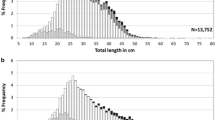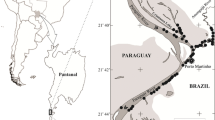Abstract
The age composition, and age- and size-dependent sex ratios of mass samples of “Honmoroko”, Gnathopogon caerulescens, were examined in Lake Biwa. The fish ranged from 0 to 2 years in age, but were mostly age 0 (97.9 %). The proportion of females was 48.6 % for age 0, 73.2 % for age 1, and 90.0 % for age 2 fish. Age 0 fish were significantly male biased, while ages 1 and 2 were significantly female biased, though the grand total showed a balanced sex ratio. The proportion of females was 48.0 % or less among age 0 fish in size classes of less than 9 cm in standard length (SL) and significantly different from a female:male ratio of 1:1 in such size classes, except for the 4–5.99 class. In size classes of 9 cm SL or greater, the proportion of females among age 0 fish was greater, more than 71.3 %, with significant differences from a balanced sex ratio for all such classes. These results suggest that G. caerulescens can be regarded as essentially an annual fish and that its spawning habits ought to result in a higher mortality for males than females, thus leading to female-biased sex ratios at ages 1 and 2.


Similar content being viewed by others
References
Clutton-Brock TH, Vincent ACJ (1991) Sexual selection and the potential reproductive rates of males and females. Nature 351:58–60
Conover DO (2004) Temperature-dependent sex determination in fishes. In: Valenzuela N, Lance VA (ed) Temperature-dependent sex determination in vertebrates. Smithsonian Books, Washington. pp 11–20
Fujioka Y (2001a) Present status of the stock enhancement and culture research of honmoroko Gnathopogon caerulescens. Bull Shiga Pref Fish Exp Stat 48:47–56
Fujioka Y (2001b) Thermolabile sex determination in honmoroko. J Fish Biol 59:851–861
Fujioka Y (2006) Patterns of sex ratio response to water temperature during sex determination in honmoroko Gnathopogon caerulescens. Fisher Sci 72:1034–1041
Fujioka Y (2008) Effect of rearing temperatures on juvenile growth of honmoroko Gnathopogon caerulescens. Bull Shiga Pref Fish Exp Stat 52:27–31
Fujioka Y (2011) Sex differentiation in honmoroko Gnathopogon caerulescens. Bull Shiga Pref Fish Exp Stat 54:167–172
Fujioka Y (2013) Present status and conservation of the endangered endemic Lake Biwa cyprinids, Honmoroko (Gnathopogon caerulescens), Nigorobuna (Carassius auratus grandoculis), and Gengoroubuna (Carassius cuvieri). Jpn J Ichthyol 60:57–63
Fujioka Y, Taguchi T, Kikko T (2013) Spawning time, spawning frequency and spawned egg number in a multiple-spawning fish, the honmoroko Gnathopogon caerulescens. Nippon Suisan Gakkaishi 79:31–37
Godin JGJ (1997) Evading predators. In: Godin JGJ (ed) Behavioral ecology of teleost fishes. Oxford University Press, Oxford. pp 191–236
Hanson KC, Gravel MA, Graham A, Shoji A, Cooke SJ (2008) Sexual variation in fisheries research and management: When does sex matter? Rev Fish Sci 16:421–436
Hosoya K (2013) Honmoroko (Genus Gnathopogon). In: Nakabo T (ed) Fish of Japan with pictorial key to the species, third edition. Tokai University Press, Hadano. pp 324
Kikko T, Okamoto H, Ujiie M, Ishizaki D, Usuki T, Nemoto M, Saegusa J, Kai Y, Fujioka Y (2014) Spawning ecology of Honmoroko, Gnathopogon caerulescens, in inlets of the Nishinoko lagoon, Lake Biwa, Japan. Jpn J Ichthyol 61:1–8
Maki I (1966) Population studies of honmoroko, Gnathopogon caerulescens Sauvage, in Lake Biwa, Japan, 1. On the critical life-cycle stages related to the annual fluctuation of the population. Jpn J Ecol 16:183–190
Nakamura M (1949) The life history of a cyprinid fish, Gnathopogon elongates caerulescens (Sauvage) in Lake Biwa. Nippon Suisan Gakkaishi 15:88–96
Nakamura M (1969) Honmoroko, In: Nakamura M (ed) Cyprinid fishes in Japan Sigenkagaku-kenkyusho, Tokyo. pp 117–125
Okuzawa, K, Furukawa, K, Aida, K, Hanyu, I (1986) Annual reproductive cycle of the honmoroko Gnathopogon elongatus caerulescens. Bull Japan Soc Sci Fish 52:1957–1960
Okuzawa, K, Furukawa, K, Aida, K, Hanyu, I (1989) Effects of photoperiod and temperature on gonadal maturation, and plasma steroid and gonadotropin levels in a cyprinid fish, the honmoroko Gnathopogon elongatus caerulescens. Gen Comp Endocrinol 75:139–147
Okuzawa, K, Furukawa, K, Aida, K, Hanyu, I (1994) The effects of water temperature on gonadotropin-releasing hormone contents in the discrete brain areas and pituitary of male honmoroko Gnathopogon elongatus caerulescens. Fisher Sci 60:155–158
Saegusa J (2012) Study of the honmoroko caught by gill-net around Iba-naiko lagoon. Annu Rep Shiga Pref Fish Exp Stat, Heisei 22, pp 19
Acknowledgments
We thank Dr. Mark J. Grygier (Lake Biwa Museum) for his critical reading of the manuscript and the staffs of the Shiga Prefecture Fisheries Experiment Station for help in various aspects of this study.
Author information
Authors and Affiliations
Corresponding author
About this article
Cite this article
Fujioka, Y., Saegusa, J. Sex ratios in relation to age and body size in “Honmoroko”, Gnathopogon caerulescens . Ichthyol Res 62, 512–515 (2015). https://doi.org/10.1007/s10228-014-0452-5
Received:
Revised:
Accepted:
Published:
Issue Date:
DOI: https://doi.org/10.1007/s10228-014-0452-5




